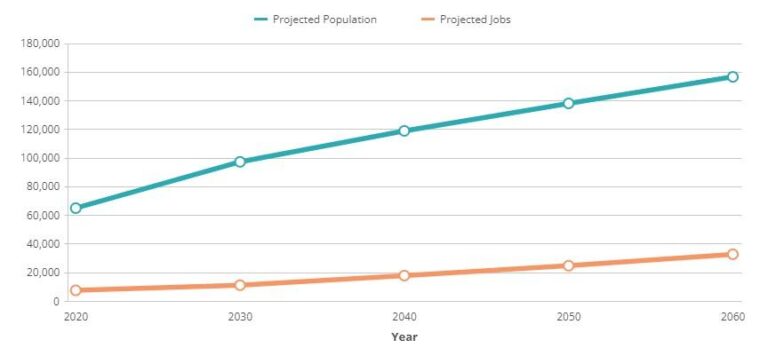Maricopa County continues to lead the nation as the fastest-growing county in the United States, according to the latest U.S. Census data. This rapid population increase underscores the region’s expanding economic opportunities, rising housing demand, and shifting demographic trends. As Maricopa County sustains its growth momentum, local officials and businesses face both new challenges and prospects in managing the area’s development and infrastructure needs.
Maricopa County Population Surge Outpaces National Growth Trends
Maricopa County’s remarkable population increase continues to outpace other regions across the United States, underscoring its status as a premier destination for both families and businesses. Driven by robust economic opportunities, favorable climate, and expanding infrastructure, the county’s growth rate surpassed national averages significantly in recent Census data. This demographic surge has created a dynamic shift in the local economy, pushing demand for housing, education, and healthcare to new heights.
The Census Bureau’s recent data highlights several key factors behind this population boom:
- Job growth: Thriving sectors such as technology, finance, and healthcare attract a skilled workforce.
- Migration trends: Influx of residents from higher-cost states seeking affordable living and quality of life.
- Infrastructure development: Investments in transportation and public services accommodate expanding communities.
| Metric | Maricopa County | National Average |
|---|---|---|
| Population Growth Rate (2020-2024) | 14.8% | 6.5% |
| Net Migration | +180,000 | +50,000 |
| Housing Starts (2023) | 25,000 units | 12,000 units |
Economic Implications of Rapid Expansion in Maricopa County
The swift population surge in Maricopa County has ignited substantial economic reverberations across various sectors. Consumer demand has skyrocketed, fueling growth in retail, real estate, and services, while simultaneously placing strain on infrastructure and public resources. Businesses are capitalizing on this influx, attracting talent and investment, which in turn creates a dynamic job market. However, the rapid expansion has also led to rising housing costs and increased traffic congestion, posing challenges for long-term sustainability.
Key economic impacts include:
- Boost in construction and development projects, creating thousands of jobs and stimulating local economies.
- Expansion of tech and healthcare industries, serving a growing and diverse population.
- Pressure on transportation systems, demanding public and private sector collaboration to enhance infrastructure.
- Increased tax revenues, enabling public investments but also raising concerns about equitable resource distribution.
| Sector | Impact | Projection (5 years) |
|---|---|---|
| Construction | Employment growth | +15% |
| Real Estate | Price appreciation | +20% |
| Healthcare | Facility expansions | +12% |
| Transportation | Infrastructure demands | +25% |
Infrastructure Challenges and Opportunities Amidst Population Boom
Maricopa County’s rapid population surge presents a dual-edged sword for urban planners and local governments. With more residents flocking to the region, existing infrastructure systems face unprecedented strain. Transportation networks, including highways and public transit, are struggling to keep pace with growing demand, resulting in increased traffic congestion and longer commute times. Additionally, water and energy resources are under pressure as the county seeks sustainable solutions to support its expanding populace.
Nonetheless, this growth also opens doors for innovation and strategic investment. Key opportunities lie in:
- Smart infrastructure development: Incorporating IoT and data analytics to optimize traffic flow and resource distribution.
- Green building initiatives: Promoting energy-efficient construction to reduce environmental impact.
- Public-private partnerships: Leveraging collaboration to fund and accelerate critical projects.
| Infrastructure Sector | Current Challenge | Opportunity |
|---|---|---|
| Transportation | Congestion and limited transit options | Expansion of light rail and smart signaling |
| Water Supply | Resource scarcity amid rising demand | Water recycling and conservation programs |
| Energy | Increasing consumption and grid stress | Renewable energy integration |
Strategic Recommendations for Sustainable Development in Maricopa County
To manage the continued surge in population effectively, local authorities and planners must prioritize sustainable infrastructure development that meets the demands of growth without compromising environmental integrity. Key initiatives should include expanding public transit networks to reduce traffic congestion and carbon emissions, investing in renewable energy sources to power new developments, and implementing robust water conservation programs to address the region’s arid climate challenges. Collaboration with private sectors can accelerate innovation in green building technologies and smart city solutions, fostering resilience and economic vitality simultaneously.
Critical strategic actions include:
- Enhancing multi-modal transportation options across urban and suburban zones
- Promoting energy-efficient construction standards and retrofitting existing infrastructure
- Strengthening water resource management through advanced reclamation and usage optimization
- Expanding green spaces to improve air quality and community well-being
- Driving equitable development that supports affordable housing and economic inclusion
| Focus Area | Target Outcome | Timeline |
|---|---|---|
| Transportation | 30% reduction in emissions by 2030 | 2024–2030 |
| Energy | 50% renewable energy use by 2035 | 2024–2035 |
| Water Management | 20% decrease in consumption per capita | 2024–2028 |
| Housing | 15% increase in affordable units | 2024–2029 |
In Retrospect
As Maricopa County continues to lead the nation in population growth, the region faces both opportunities and challenges that come with rapid expansion. Economic development, infrastructure demands, and community planning will remain central priorities as officials and residents adapt to this dynamic shift. With its position as the fastest-growing county confirmed by the latest Census data, Maricopa County’s trajectory will be closely watched as a bellwether for broader demographic and economic trends across the United States.





